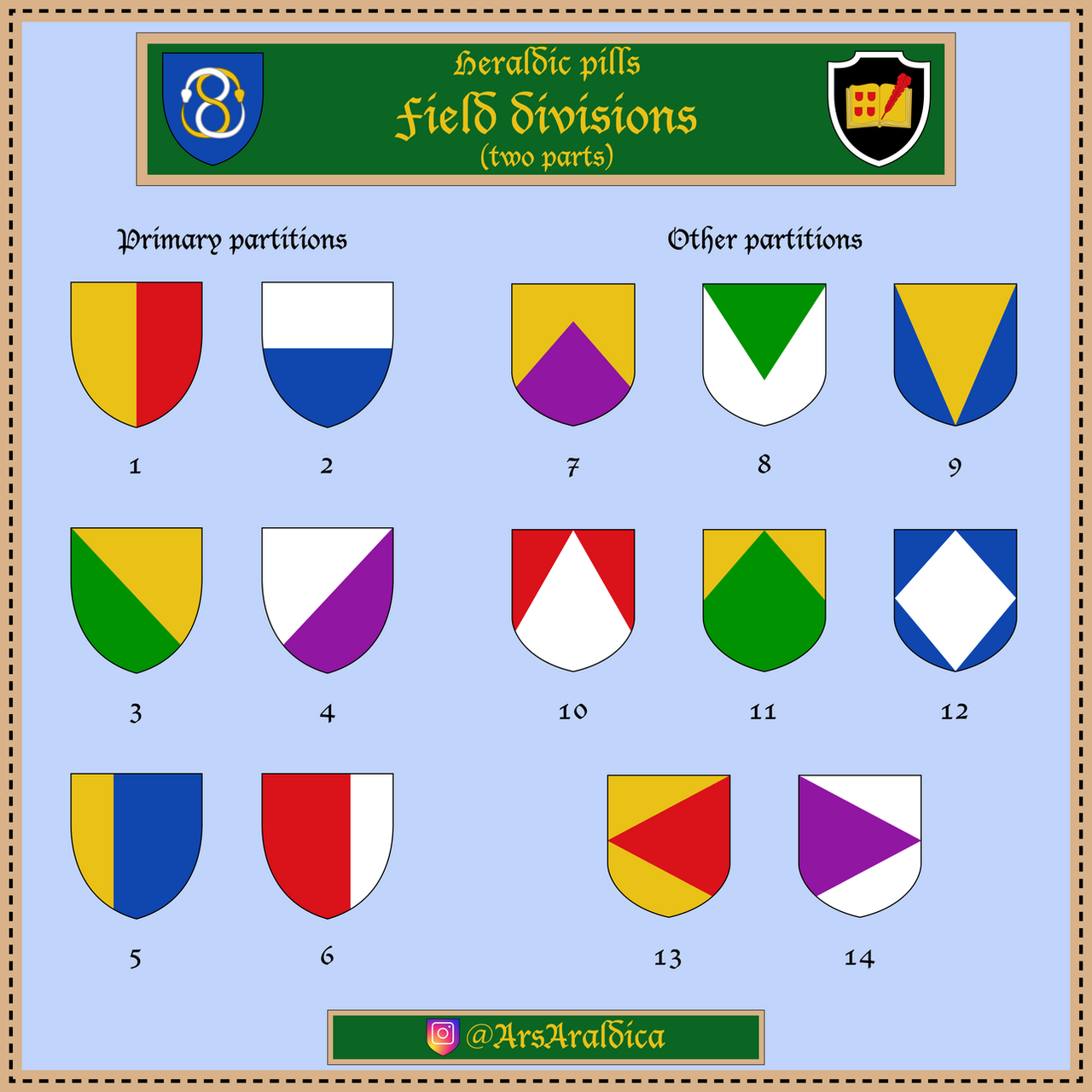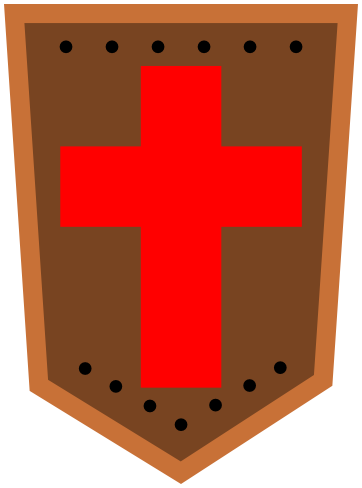HOME | DD
 Nunkij — Field divisions (two parts)
by-nc-nd
Nunkij — Field divisions (two parts)
by-nc-nd

#blason #blazon #coa #coatofarms #fictional #heraldic #heraldry #original #pill #pillola #pillole #pills #scudo #stemma #blasone #araldica #heraldicpills #pillolediaraldica #arsaraldica #pillnumber8 #pillolanumero8
Published: 2019-12-26 12:01:04 +0000 UTC; Views: 670; Favourites: 2; Downloads: 1
Redirect to original
Description
Field divisions (two parts)Primary partitions
1. Per pale - Per pale or and gules.
2. Per fess - Per fess argent and azure.
3. Per bend - Per bend or and vert.
4. Per bend sinister - Per bend sinister argent and purpure.
5. Per pale in flank dexter - Per pale in flank dexter azure and or (Azure, a flank dexter or).
6. Per pale in flank sinister - Per pale in flank sinister gules and argent (Gules, a flank sinister argent).
Other partitions
7. Per chevron - Per chevron or and purpure.
8. Per chevron inverted - Per chevron inverted vert and argent.
9. Chaussé - Or, chaussé azure.
10. Mantled - Argent, mantled gules.
11. Chapé - Vert, chapé or.
12. Vetu - Argent, vetu azure. This is not considered a partition.
13. Embrassé dexter - Gules, embrassé dexter, or.
14. Embrassé sinister - Purpure, embrassé sinister, argent.
Partitions are divisions of the shield along the directions of the main ordinaries. The areas created by a partition are considered on the same level, therefore they do not follow the rule of tinctures that applies only to those elements that are one upon the other. In practice many coats of arms use a combination of colour and metal when divided into two areas by a partition.
Primary partitions that follow the main four heraldic directions [1-4] divide the shield into two parts (that are) of the same size.
When a partition divides the shield into two areas that have no figures, we have to specify only the tinctures.
E.g.: Per pale gules and or. [a]
When a partition divides the shield into two areas that have various figures, we have to introduce them with an ordinal number and describe them as single shields.
E.g..: Per pale: the first: gules, a lion argent; the second: or, a fess sable. [b]
Areas are numbered using a crescent right-to-left and top-to-bottom order.
Every partition specified divides the shields into two areas, so we have to use only two tinctures. Traditionally the external area of "Vetu" [12] is not charged by figures, for this reason, probably, many heraldists do not consider it as a partition.
Partitions "Embrassé dexter" [13] and "Embrassé sinister" [14] take their name from the side of the shield where the vertex of the point is located.
Examples:
www.deviantart.com/nunkij/art/…
Partizioni semplici e altre partizioni
Partizioni semplici
1. Partito - Partito d'oro e di rosso.
2. Troncato - Troncato d'argento e d'azzurro (alcuni studiosi usano il termine di Spaccato).
3. Trinciato - Trinciato d'oro e di verde.
4. Tagliato - Tagliato d'argento e di viola.
5. Addestrato - D’azzurro, addestrato d’oro.
6. Sinistrato - Di rosso, sinistrato d’argento.
Altre partizioni
7. Troncato in scaglione - Troncato in scaglione d’oro e di viola.
8. Troncato in scaglione rovesciato - Troncato in scaglione rovesciato di verde e d’argento.
9. Calzato - D’oro, calzato d’azzurro.
10. Mantellato - D'argento, mantellato di rosso.
11. Incappato - Di verde, incappato d’oro.
12. Vestito - D’argento, vestito d’azzurro. Questa non è considerata una partizione.
13. Abbracciato a destra - Di rosso, abbracciato a destra, d’oro.
14. Abbracciato a sinistra - Di viola, abbracciato a sinistra, d’argento.
Le partizioni sono divisioni dello scudo lungo le direzioni delle pezze principali [1-11]. Le aree create da una partizione sono considerate allo stesso livello e pertanto non devono sottostare alla regola del massimo contrasto che si applica solo agli elementi posti uno sopra l’altro. Nella pratica molti stemmi utilizzano una combinazione di colore e metallo quando sono divisi in due aree da una partizione.
Le partizioni semplici che seguono le quattro principali direzioni araldiche [1-4] dividono lo scudo in due parti che hanno la stessa dimensione.
Quando una partizione divide lo scudo in due aree prive di altre figure, vengono specificati soltanto i colori.
Es: Partito di rosso e d’oro. [a]
Quando una partizione divide lo scudo in due aree che contengono diverse figure, vengono precedute da un ordinale e descritte come scudi singoli.
Es: Partito: nel primo: di rosso, al leone d’argento; nel secondo: d’oro, alla fascia di nero. [b]
La aree vengono numerate secondo l’ordine crescente che va da destra a sinistra e dall’alto al basso.
Tutte le partizioni specificate dividono lo scudo in due aree e quindi sarà necessario usare soltanto due smalti. Tradizionalmente l’area esterna alla losanga del "Vestito" [12] non viene caricata da figure, per questo motivo, probabilmente, molti araldisti non la considerano una partizione.
Le partizioni "Abbracciato a destra" [13] e "Abbracciato a sinistra" [14] prendono il nome dal lato dello scudo su cui si trova il vertice della punta.
Esempi:
www.deviantart.com/nunkij/art/…
























